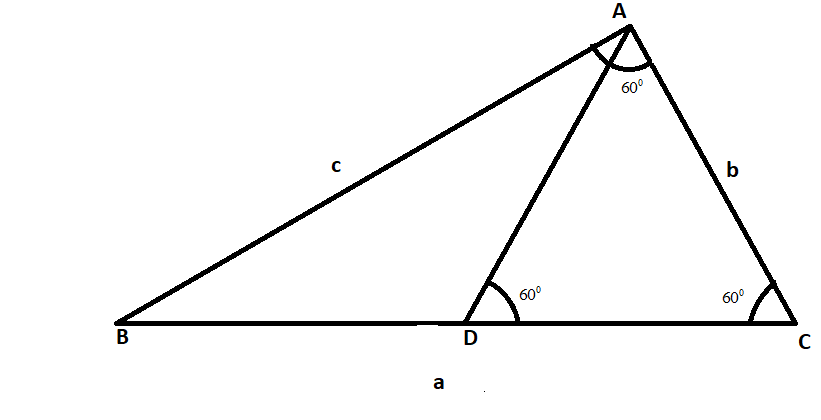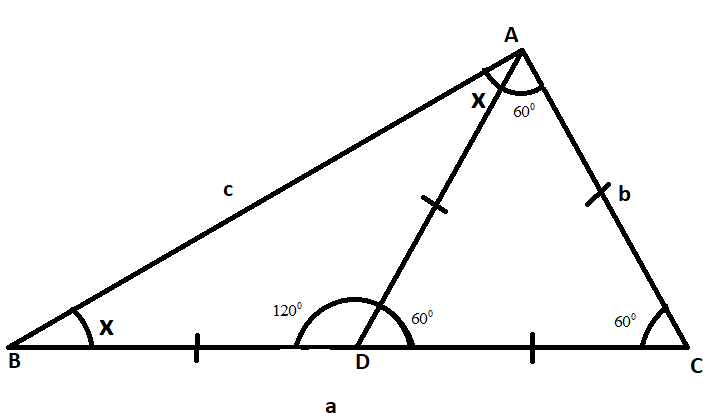
Let$D$ be the middle point of the side $BC$of a triangle $\vartriangle ABC$.if the triangle $\vartriangle ADC$is equilateral, then ${{a}^{2}}:{{b}^{2}}:{{c}^{2}}$ is equal to
A.$1:4:3$
B. $4:1:3$
C. $4:3:1$
D. $3:4:1$
Answer
218.7k+ views
Hint:
To solve this question, we will find all the angles of the triangle $\vartriangle ABC$ using properties and theorems of the triangle. After this we will use Law of sine $\frac{a}{\sin A}=\frac{b}{\sin B}=\frac{c}{\sin C}$and equate it some constant and by substituting all the values of the angles we will find the value of $a,b$and $c$. We will put the value of $a,b$and $c$ in ${{a}^{2}}:{{b}^{2}}:{{c}^{2}}$and then find the ratio.
Complete step-by-step solution:
We are given a triangle $\vartriangle ABC$in which $D$ is the middle point on the side $BC$. We have to find the ratio ${{a}^{2}}:{{b}^{2}}:{{c}^{2}}$if the triangle $\vartriangle ADC$is equilateral.
In triangle $\vartriangle ABC$, the value of the sides will be,
$AB=c,BC=a$ and $AC=b$.
Now we will make the diagram of the triangle $\vartriangle ABC$ with $D$ being the middle point on the side $BC$forming an equilateral triangle $\vartriangle ADC$.

Because the triangle $\vartriangle ADC$is equilateral each of the angles in this triangle will be ${{60}^{0}}$ and all the sides will be also equal. That is
$AD=AC=DC$
And as $D$is the mid-point of side $BC$ so,
$BD=DC$
From here we can say that in triangle $\vartriangle ABD$, the sides \[BD\] and $AD$will be equal, that is $BD=AD$ making it an isosceles triangle. And by the theorem of an isosceles triangle we know that angles opposite to the equal sides of an isosceles triangle are also equal.
Hence,
$\angle ABD=\angle DAB$
Let this angle be $x$ so,
$\angle ABD=\angle DAB=x$
Now we know that the angle formed on the straight line is ${{180}^{0}}$. So to calculate the angle $\angle ADB$ we will subtract $\angle ADC$ from ${{180}^{0}}$.
$\begin{align}
& \angle ADB={{180}^{0}}-{{60}^{0}} \\
& ={{120}^{0}}
\end{align}$

We will now find the value of angle $x$ using the angle sum property of the triangle.
$\begin{align}
& \angle BAD+\angle ADB+\angle ABD={{180}^{0}} \\
& x+x+{{120}^{0}}={{180}^{0}} \\
& 2x={{60}^{0}} \\
& x={{30}^{0}}
\end{align}$
We will now apply the Law of sine by equating to some constant $k$,
$\begin{align}
& \frac{a}{\sin A}=\frac{b}{\sin B}=\frac{c}{\sin C}=k \\
& \frac{a}{\sin ({{60}^{0}}+{{30}^{0}})}=\frac{b}{\sin {{30}^{0}}}=\frac{c}{\sin {{60}^{0}}}=k \\
& \frac{a}{1}=\frac{b}{\frac{1}{2}}=\frac{c}{\frac{\sqrt{3}}{2}}=k \\
& a=2b=\frac{2c}{\sqrt{3}}=k
\end{align}$
The values of $a,b$and $c$ will be,
$\begin{align}
& a=k \\
& b=\frac{k}{2} \\
& c=\frac{\sqrt{3}k}{2}
\end{align}$
Hence the value of ${{a}^{2}}:{{b}^{2}}:{{c}^{2}}$will be,
\[\ {{a}^{2}}:{{b}^{2}}:{{c}^{2}}=1:\frac{1}{4}:\frac{3}{4}\]
\[\ {{a}^{2}}:{{b}^{2}}:{{c}^{2}}=4:1:3\]
The triangle $\vartriangle ABC$ on which $D$ is the middle point on the side $BC$of a triangle forming an equilateral triangle$\vartriangle ADC$, then ${{a}^{2}}:{{b}^{2}}:{{c}^{2}}$ is equal to $4:1:3$.Hence the correct option is (B).
Note:
The angle sum property which we have used in the solution to find the value of $x$, is a property of a triangle which states that the sum of all the interior angles in a triangle is equal to {{180}^{0}}. This property applies on each and every type of triangle whether it is acute, obtuse or a right angled triangle.
To solve this question, we will find all the angles of the triangle $\vartriangle ABC$ using properties and theorems of the triangle. After this we will use Law of sine $\frac{a}{\sin A}=\frac{b}{\sin B}=\frac{c}{\sin C}$and equate it some constant and by substituting all the values of the angles we will find the value of $a,b$and $c$. We will put the value of $a,b$and $c$ in ${{a}^{2}}:{{b}^{2}}:{{c}^{2}}$and then find the ratio.
Complete step-by-step solution:
We are given a triangle $\vartriangle ABC$in which $D$ is the middle point on the side $BC$. We have to find the ratio ${{a}^{2}}:{{b}^{2}}:{{c}^{2}}$if the triangle $\vartriangle ADC$is equilateral.
In triangle $\vartriangle ABC$, the value of the sides will be,
$AB=c,BC=a$ and $AC=b$.
Now we will make the diagram of the triangle $\vartriangle ABC$ with $D$ being the middle point on the side $BC$forming an equilateral triangle $\vartriangle ADC$.

Because the triangle $\vartriangle ADC$is equilateral each of the angles in this triangle will be ${{60}^{0}}$ and all the sides will be also equal. That is
$AD=AC=DC$
And as $D$is the mid-point of side $BC$ so,
$BD=DC$
From here we can say that in triangle $\vartriangle ABD$, the sides \[BD\] and $AD$will be equal, that is $BD=AD$ making it an isosceles triangle. And by the theorem of an isosceles triangle we know that angles opposite to the equal sides of an isosceles triangle are also equal.
Hence,
$\angle ABD=\angle DAB$
Let this angle be $x$ so,
$\angle ABD=\angle DAB=x$
Now we know that the angle formed on the straight line is ${{180}^{0}}$. So to calculate the angle $\angle ADB$ we will subtract $\angle ADC$ from ${{180}^{0}}$.
$\begin{align}
& \angle ADB={{180}^{0}}-{{60}^{0}} \\
& ={{120}^{0}}
\end{align}$

We will now find the value of angle $x$ using the angle sum property of the triangle.
$\begin{align}
& \angle BAD+\angle ADB+\angle ABD={{180}^{0}} \\
& x+x+{{120}^{0}}={{180}^{0}} \\
& 2x={{60}^{0}} \\
& x={{30}^{0}}
\end{align}$
We will now apply the Law of sine by equating to some constant $k$,
$\begin{align}
& \frac{a}{\sin A}=\frac{b}{\sin B}=\frac{c}{\sin C}=k \\
& \frac{a}{\sin ({{60}^{0}}+{{30}^{0}})}=\frac{b}{\sin {{30}^{0}}}=\frac{c}{\sin {{60}^{0}}}=k \\
& \frac{a}{1}=\frac{b}{\frac{1}{2}}=\frac{c}{\frac{\sqrt{3}}{2}}=k \\
& a=2b=\frac{2c}{\sqrt{3}}=k
\end{align}$
The values of $a,b$and $c$ will be,
$\begin{align}
& a=k \\
& b=\frac{k}{2} \\
& c=\frac{\sqrt{3}k}{2}
\end{align}$
Hence the value of ${{a}^{2}}:{{b}^{2}}:{{c}^{2}}$will be,
\[\ {{a}^{2}}:{{b}^{2}}:{{c}^{2}}=1:\frac{1}{4}:\frac{3}{4}\]
\[\ {{a}^{2}}:{{b}^{2}}:{{c}^{2}}=4:1:3\]
The triangle $\vartriangle ABC$ on which $D$ is the middle point on the side $BC$of a triangle forming an equilateral triangle$\vartriangle ADC$, then ${{a}^{2}}:{{b}^{2}}:{{c}^{2}}$ is equal to $4:1:3$.Hence the correct option is (B).
Note:
The angle sum property which we have used in the solution to find the value of $x$, is a property of a triangle which states that the sum of all the interior angles in a triangle is equal to {{180}^{0}}. This property applies on each and every type of triangle whether it is acute, obtuse or a right angled triangle.
Recently Updated Pages
The maximum number of equivalence relations on the-class-11-maths-JEE_Main

A train is going from London to Cambridge stops at class 11 maths JEE_Main

Find the reminder when 798 is divided by 5 class 11 maths JEE_Main

An aeroplane left 50 minutes later than its schedu-class-11-maths-JEE_Main

A man on the top of a vertical observation tower o-class-11-maths-JEE_Main

In an election there are 8 candidates out of which class 11 maths JEE_Main

Trending doubts
JEE Main 2026: Application Form Open, Exam Dates, Syllabus, Eligibility & Question Papers

Derivation of Equation of Trajectory Explained for Students

Hybridisation in Chemistry – Concept, Types & Applications

Understanding the Angle of Deviation in a Prism

Understanding Collisions: Types and Examples for Students

Understanding Atomic Structure for Beginners

Other Pages
JEE Advanced Marks vs Ranks 2025: Understanding Category-wise Qualifying Marks and Previous Year Cut-offs

NCERT Solutions for Class 11 Maths Chapter 10 Conic Sections

NCERT Solutions for Class 11 Maths Chapter 9 Straight Lines

NCERT Solutions For Class 11 Maths Chapter 8 Sequences And Series

How to Convert a Galvanometer into an Ammeter or Voltmeter

NCERT Solutions For Class 11 Maths Chapter 12 Limits And Derivatives




